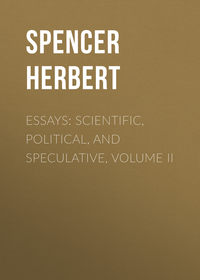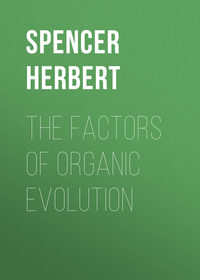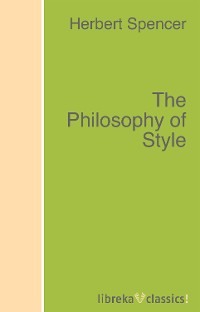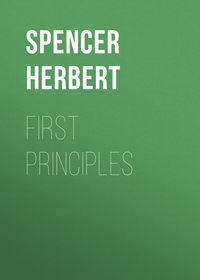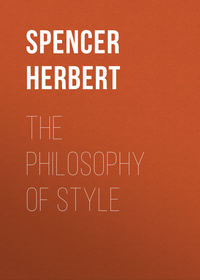 полная версия
полная версияThe Principles of Biology, Volume 1 (of 2)
Continuance of the comparison shows that vital changes, both visceral and cerebral, differ from other changes in their heterogeneity. Neither the simultaneous acts nor the serial acts, which together constitute the process of digestion, are alike. The states of consciousness comprised in any ratiocination are not repetitions one of another, either in composition or in modes of dependence. Inorganic processes, on the other hand, even when like organic ones in the number of the simultaneous and successive changes they involve, are unlike them in the relative homogeneity of these changes. In the case of the sea, just referred to, it is observable that countless as are the actions at any moment going on, they are mostly mechanical actions that are to a great degree similar; and in this respect differ widely from the actions at any moment taking place in an organism. Even where life is nearly simulated, as by the working of a steam-engine, we see that considerable as is the number of simultaneous changes, and rapid as are the successive ones, the regularity with which they soon recur in the same order and degree, renders them unlike those varied changes exhibited by a living creature. Still, this peculiarity, like the foregoing ones, does not divide the two classes of changes with precision; since there are inanimate things presenting considerable heterogeneity of change: for instance, a cloud. The variations of state which this undergoes, both simultaneous and successive, are many and quick; and they differ widely from one another both in quality and quantity. At the same instant there may occur change of position, change of form, change of size, change of density, change of colour, change of temperature, change of electric state; and these several kinds of change are continuously displayed in different degrees and combinations. Yet when we observe that very few inorganic objects manifest heterogeneity of change comparable to that manifested by organic objects, and further, that in ascending from low to high forms of life, we meet with an increasing variety in the kinds of changes displayed; we see that there is here a further leading distinction between vital and non-vital actions. According to this modified conception, then, Life is made up of heterogeneous changes both simultaneous and successive.
If, now, we look for some trait common to the nutritive and logical processes, by which they are distinguished from those inorganic processes that are most like them in the heterogeneity of the simultaneous and successive changes they comprise, we discover that they are distinguished by the combination among their constituent changes. The acts which make up digestion are mutually dependent. Those composing a train of reasoning are in close connection. And, generally, it is to be remarked of vital changes, that each is made possible by all, and all are affected by each. Respiration, circulation, absorption, secretion, in their many sub-divisions, are bound up together. Muscular contraction involves chemical change, change of temperature, and change in the excretions. Active thought influences the operations of the stomach, of the heart, of the kidneys. But we miss this union among non-vital activities. Life-like as may seem the action of a volcano in respect of the heterogeneity of its many simultaneous and successive changes, it is not life-like in respect of their combination. Though the chemical, mechanical, thermal, and electric phenomena exhibited have some inter-dependence, yet the emissions of stones, mud, lava, flame, ashes, smoke, steam, take place irregularly in quantity, order, intervals, and mode of conjunction. Even here, however, it cannot be said that inanimate things present no parallels to animate ones. A glacier may be instanced as showing nearly as much combination in its change as a plant of the lowest organization. It is ever growing and ever decaying; and the rates of its composition and decomposition preserve a tolerably constant ratio. It moves; and its motion is in immediate dependence on its thawing. It emits a torrent of water, which, in common with its motion, undergoes annual variations as plants do. During part of the year the surface melts and freezes alternately; and on these changes depend the variations in movement, and in efflux of water. Thus we have growth, decay, changes of temperature, changes of consistence, changes of velocity, changes of excretion, all going on in connexion; and it may be as truly said of a glacier as of an animal, that by ceaseless integration and disintegration it gradually undergoes an entire change of substance without losing its individuality. This exceptional instance, however, will scarcely be held to obscure that broad distinction from inorganic processes which organic processes derive from the combination among their constituent changes. And the reality of this distinction becomes yet more manifest when we find that, in common with previous ones, it not only marks off the living from the not-living, but also things which live little from things which live much. For while the changes going on in a plant or a zoophyte are so imperfectly combined that they can continue after it has been divided into two or more pieces, the combination among the changes going on in a mammal is so close that no part cut off from the rest can live, and any considerable disturbance of one chief function causes a cessation of the others. Hence, as we now regard it, Life is a combination of heterogeneous changes, both simultaneous and successive.
When we once more look for a character common to these two kinds of vital action, we perceive that the combinations of heterogeneous changes which constitute them, differ from the few combinations which they otherwise resemble, in respect of definiteness. The associated changes going on in a glacier, admit of indefinite variation. Under a conceivable alteration of climate, its thawing and its progression may be stopped for a million years, without disabling it from again displaying these phenomena under appropriate conditions. By a geological convulsion, its motion may be arrested without an arrest of its thawing; or by an increase in the inclination of the surface it slides over, its motion may be accelerated without accelerating its rate of dissolution. Other things remaining the same, a more rapid deposit of snow may cause great increase of bulk; or, conversely, the accretion may entirely cease, and yet all the other actions continue until the mass disappears. Here, then, the combination has none of that definiteness which, in a plant, marks the mutual dependence of respiration, assimilation, and circulation; much less has it that definiteness seen in the mutual dependence of the chief animal functions; no one of which can be varied without varying the rest; no one of which can go on unless the rest go on. Moreover, this definiteness of combination distinguishes the changes occurring in a living body from those occurring in a dead one. Decomposition exhibits both simultaneous and successive changes, which are to some extent heterogeneous, and in a sense combined; but they are not combined in a definite manner. They vary according as the surrounding medium is air, water, or earth. They alter in nature with the temperature. If the local conditions are unlike, they progress differently in different parts of the mass, without mutual influence. They may end in producing gases, or adipocire, or the dry substance of which mummies consist. They may occupy a few days or thousands of years. Thus, neither in their simultaneous nor in their successive changes, do dead bodies display that definiteness of combination which characterizes living ones. It is true that in some inferior creatures the cycle of successive changes admits of a certain indefiniteness – that it may be suspended for a long period by desiccation or freezing, and may afterwards go on as though there had been no breach in its continuity. But the circumstance that only a low order of life can have its changes thus modified, serves but to suggest that, like the previous characteristics, this characteristic of definiteness in its combined changes, distinguishes high vitality from low vitality, as it distinguishes low vitality from inorganic processes. Hence, our formula as further amended reads thus: – Life is a definite combination of heterogenous changes, both simultaneous and successive.
Finally, we shall still better express the facts if, instead of saying a definite combination of heterogeneous changes, we say the definite combination of heterogeneous changes. As it at present stands, the definition is defective both in allowing that there may be other definite combinations of heterogeneous changes, and in directing attention to the heterogeneous changes rather than to the definiteness of their combination. Just as it is not so much its chemical elements which constitute an organism, as it is the arrangement of them into special tissues and organs; so it is not so much its heterogeneous changes which constitute Life, as it is the co-ordination of them. Observe what it is that ceases when life ceases. In a dead body there are going on heterogeneous changes, both simultaneous and successive. What then has disappeared? The definite combination has disappeared. Mark, too, that however heterogeneous the simultaneous and successive changes exhibited by such an inorganic object as a volcano, we much less tend to think of it as living than we do a watch or a steam-engine, which, though displaying changes that, serially contemplated, are largely homogeneous, displays them definitely combined. So dominant an element is this in our idea of Life, that even when an object is motionless, yet, if its parts be definitely combined, we conclude either that it has had life, or has been made by something having life. Thus, then, we conclude that Life is —the definite combination of heterogeneous changes, both simultaneous and successive.
§ 26. Such is the conception at which we arrive without changing our stand-point. It is, however, an incomplete conception. This ultimate formula (which is to a considerable extent identical with one above given – "the co-ordination of actions;" seeing that "definite combination" is synonymous with "co-ordination," and "changes both simultaneous and successive" are comprehended under the term "actions;" but which differs from it in specifying the fact, that the actions or changes are "heterogeneous") – this ultimate formula, I say, is after all but a rude approximation. It is true that it does not fail by including the growth of a crystal; for the successive changes this implies cannot be called heterogeneous. It is true that the action of a galvanic battery is not comprised in it; since here, too, heterogeneity is not exhibited by the successive changes. It is true that by this same qualification the motions of the Solar System are excluded, as are also those of a watch and a steam-engine. It is true, moreover, that while, in virtue of their heterogeneity, the actions going on in a cloud, in a volcano, in a glacier, fulfil the definition; they fall short of it in lacking definiteness of combination. It is further true that this definiteness of combination distinguishes the changes taking place in an organism during life from those which commence at death. And beyond all this it is true that, as well as serving to mark off, more or less clearly, organic actions from inorganic actions, each member of the definition serves to mark off the actions constituting high vitality from those constituting low vitality; seeing that life is high in proportion to the number of successive changes occurring between birth and death; in proportion to the number of simultaneous changes; in proportion to the heterogeneity of the changes; in proportion to the combination subsisting among the changes; and in proportion to the definiteness of their combination. Nevertheless, answering though it does to so many requirements, this definition is essentially defective. The definite combination of heterogeneous changes, both simultaneous and successive, is a formula which fails to call up an adequate conception. And it fails from omitting the most distinctive peculiarity – the peculiarity of which we have the most familiar experience, and with which our notion of Life is, more than with any other, associated. It remains now to supplement the conception by the addition of this peculiarity.
CHAPTER V.
THE CORRESPONDENCE BETWEEN LIFE AND ITS CIRCUMSTANCES
§ 27. We habitually distinguish between a live object and a dead one, by observing whether a change which we make in the surrounding conditions, or one which Nature makes in them, is or is not followed by some perceptible change in the object. By discovering that certain things shrink when touched, or fly away when approached, or start when a noise is made, the child first roughly discriminates between the living and the not-living; and the man when in doubt whether an animal he is looking at is dead or not, stirs it with his stick; or if it be at a distance, shouts, or throws a stone at it. Vegetal and animal life are alike primarily recognized by this process. The tree that puts out leaves when the spring brings increase of temperature, the flower which opens and closes with the rising and setting of the sun, the plant that droops when the soil is dry and re-erects itself when watered, are considered alive because of these induced changes; in common with the acorn-shell which contracts when a shadow suddenly falls on it, the worm that comes to the surface when the ground is continuously shaken, and the hedgehog that rolls itself up when attacked.
Not only, however, do we look for some response when an external stimulus is applied to a living organism, but we expect a fitness in the response. Dead as well as living things display changes under certain changes of condition: instance, a lump of carbonate of soda that effervesces when dropped into sulphuric acid; a cord that contracts when wetted; a piece of bread that turns brown when held near the fire. But in these cases, we do not see a connexion between the changes undergone and the preservation of the things that undergo them; or, to avoid any teleological implication – the changes have no apparent relations to future events which are sure or likely to take place. In vital changes, however, such relations are manifest. Light being necessary to vegetal life, we see in the action of a plant which, when much shaded, grows towards the unshaded side, an appropriateness which we should not see did it grow otherwise. Evidently the proceedings of a spider which rushes out when its web is gently shaken and stays within when the shaking is violent, conduce better to the obtainment of food and the avoidance of danger than were they reversed. The fact that we feel surprise when, as in the case of a bird fascinated by a snake, the conduct tends towards self-destruction, at once shows how generally we have observed an adaptation of living changes to changes in surrounding circumstances.
A kindred truth, rendered so familiar by infinite repetition that we forget its significance, must be named. There is invariably, and necessarily, a conformity between the vital functions of any organism and the conditions in which it is placed – between the processes going on inside of it and the processes going on outside of it. We know that a fish cannot live long in air, or a man under water. An oak growing in the ocean and a seaweed on the top of a hill, are incredible combinations of ideas. We find that each kind of animal is limited to a certain range of climate; each kind of plant to certain zones of latitude and elevation. Of the marine flora and fauna, each species is found only between such and such depths. Some blind creatures flourish in dark caves; the limpet where it is alternately covered and uncovered by the tide; the red-snow alga rarely elsewhere than in the arctic regions or among alpine peaks.
Grouping together the cases first named, in which a particular change in the circumstances of an organism is followed by a particular change in it, and the cases last named, in which the constant actions occurring within an organism imply some constant actions occurring without it; we see that in both, the changes or processes displayed by a living body are specially related to the changes or processes in its environment. And here we have the needful supplement to our conception of Life. Adding this all-important characteristic, our conception of Life becomes – The definite combination of heterogeneous changes, both simultaneous and successive, in correspondence with external co-existences and sequences. That the full significance of this addition may be seen, it will be necessary to glance at the correspondence under some of its leading aspects.17
§ 28. Neglecting minor requirements, the actions going on in a plant pre-suppose a surrounding medium containing at least carbonic acid and water, together with a due supply of light and a certain temperature. Within the leaves carbon is being appropriated and oxygen given off; without them, is the gas from which the carbon is taken, and the imponderable agents that aid the abstraction. Be the nature of the process what it may, it is clear that there are external elements prone to undergo special re-arrangements under special conditions. It is clear that the plant in sunshine presents these conditions and so effects these re-arrangements. And thus it is clear that the changes which primarily constitute the plant's life, are in correspondence with co-existences in its environment.
If, again, we ask respecting the lowest protozoon how it lives; the answer is, that while on the one hand its substance is undergoing disintegration, it is on the other hand absorbing nutriment; and that it may continue to exist, the one process must keep pace with, or exceed, the other. If further we ask under what circumstances these combined changes are possible, there is the reply that the medium in which the protozoon is placed, must contain oxygen and food – oxygen in such quantity as to produce some disintegration; food in such quantity as to permit that disintegration to be made good. In other words – the two antagonistic processes taking place internally, imply the presence externally of materials having affinities that can give rise to them.
Leaving those lowest animal forms which simply take in through their surfaces the nutriment and oxygenated fluids coming in contact with them, we pass to those somewhat higher forms which have their tissues slightly specialized. In these we see a correspondence between certain actions in the digestive sac, and the properties of certain surrounding bodies. That a creature of this order may continue to live, it is necessary not only that there be masses of substance in the environment capable of transformation into its own tissue, but also that the introduction of these masses into its stomach, shall be followed by the secretion of a solvent fluid which will reduce them to a fit state for absorption. Special outer properties must be met by special inner properties.
When, from the process by which food is digested, we turn to the process by which it is seized, the same general truth faces us. The stinging and contractile power of a polype's tentacle, correspond to the sensitiveness and strength of the creatures serving it for prey. Unless that external change which brings one of these creatures in contact with the tentacle, were quickly followed by those internal changes which result in the coiling and drawing up of the tentacle, the polype would die of inanition. The fundamental processes of integration and disintegration within it, would get out of correspondence with the agencies and processes without it, and the life would cease.
Similarly, when the creature becomes so large that its tissue cannot be efficiently supplied with nutriment by mere absorption through its lining membrane, or duly oxygenated by contact with the fluid bathing its surface, there arises a need for a distributing system by which nutriment and oxygen may be carried throughout the mass; and the functions of this system, being subsidiary to the two primary functions, form links in the correspondence between internal and external actions. The like is obviously true of all those subordinate functions, secretory and excretory, that facilitate oxidation and assimilation.
Ascending from visceral actions to muscular and nervous actions, we find the correspondence displayed in a manner still more obvious. Every act of locomotion implies the expenditure of certain internal forces, adapted in amounts and directions to balance or out-balance certain external forces. The recognition of an object is impossible without a harmony between the changes constituting perception, and particular properties co-existing in the environment. Escape from enemies implies motions within the organism, related in kind and rapidity to motions without it. Destruction of prey requires a special combination of subjective actions, fitted in degree and succession to overcome a group of objective ones. And so with those countless automatic processes constituting instincts.
In the highest order of vital changes the same fact is equally manifest. The empirical generalization that guides the farmer in his rotation of crops, serves to bring his actions into concord with certain of the actions going on in plants and soil. The rational deductions of the educated navigator who calculates his position at sea, form a series of mental acts by which his proceedings are conformed to surrounding circumstances. Alike in the simplest inferences of the child and the most complex ones of the man of science, we find a correspondence between simultaneous and successive changes in the organism, and co-existences and sequences in its environment.
§ 29. This general formula which thus includes the lowest vegetal processes along with the highest manifestations of human intelligence, will perhaps call forth some criticisms which it is desirable here to meet.
It may be thought that there are still a few inorganic actions included in the definition; as, for example, that displayed by the mis-named storm-glass. The feathery crystallization which, on a certain change of temperature, takes place in its contained solution, and which afterwards dissolves to reappear in new forms under new conditions, may be held to present simultaneous and successive changes that are to some extent heterogeneous, that occur with some definiteness of combination, and, above all, occur in apparent correspondence with external changes. In this case vegetal life is simulated to a considerable extent; but it is merely simulated. The relation between the phenomena occurring in the storm-glass and in the atmosphere respectively, is not a correspondence at all, in the proper sense of the word. Outside there is a thermal change; inside there is a change of atomic arrangement. Outside there is another thermal change; inside there is another change of atomic arrangement. But subtle as is the dependence of each internal upon each external change, the connexion between them does not, in the abstract, differ from the connexion between the motion of a straw and the motion of the wind that disturbs it. In either case a change produces a change, and there it ends. The alteration wrought by some environing agency on this or any other inanimate object, does not tend to induce in it a secondary alteration which anticipates some secondary alteration in the environment. But in every living body there is a tendency towards secondary alterations of this nature; and it is in their production that the correspondence consists. The difference may be best expressed by symbols. Let A be a change in the environment, and B some resulting change in an inorganic mass. Then A having produced B, the action ceases. Though the change A in the environment is followed by some consequent change a in it; no parallel sequence in the inorganic mass simultaneously generates in it some change b that has reference to the change a. But if we take a living body of the requisite organization, and let the change A impress on it some change C; then, while in the environment A is occasioning a, in the living body C will be occasioning c; of which a and c will show a certain concord in time, place, or intensity. And while it is in the continuous production of such concords or correspondences that Life consists, it is by the continuous production of them that Life is maintained.




